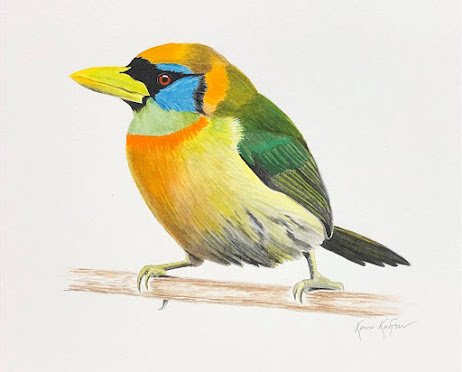The new Labrador Duck theory: Unlikely
 |
| John James Audubon's portrait of female and male Labrador Ducks. |
From Oak Harbor, Ohio, Kenn writes: A scientist recently published a new theory about the Labrador Duck, and it's drawing a lot of attention from birders and from the general public.
The interest is understandable. Labrador Duck is one of the most mysterious North American birds. Never a very common bird, it has been considered extinct since the late 1800s, and very little is known about it. There's no doubt that it existed at one time: there are still specimens in various museums, all from birds shot along the northeastern coast of North America during the fall, winter, and spring seasons in the 1700s and 1800s. But we don't know where it went for the summer (the name "Labrador" is just conjecture) and we don't know why it became extinct.
Adding to the general interest in the Labrador Duck, a possible sighting of this legendary bird is a plot element in the new feature A Birder's Guide to Everything, opening in theaters next month.
Now, Dr. E. H. McCarthy has come out with a startling suggestion. He says that perhaps the Labrador Duck isn't extinct, because maybe it never existed as a full species in the first place: It may have just been a hybrid between Common Eider and Steller's Eider.
Currently, McCarthy's paper can be reached through this link, although there have been multiple changes / additions to what is posted online within the last two days, and I'm not sure that the link will continue to work.
At first glance, the idea seems worth considering. The plumage pattern of the male was similar to that of both eiders, and the odd bill structure was similar to that of Steller's Eider. And if it had been a hybrid, that would explain why its nesting grounds were never found, and why it always seemed to exist in only small numbers.
But the more we look at the idea, the more problems arise.
1. Appearance. Hybrids don't always look intermediate between the parent species, but usually they do, and Labrador Ducks looked different from either eider in a number of ways. Its bill pattern - pale base and broad black tip - was unlike that of any eider. So was the male's wing pattern, with white secondary feathers, and its head pattern, with a large black spot on top of the head. The female also showed important differences from female eiders, including a pale throat and whitish secondaries in the wings. It would be very hard to explain all these differences if these ducks were hybrids.
2. Distribution. Common Eider and Steller's Eider do overlap in breeding range, so it would be possible for them to interbreed. However, the known areas of overlap (currently and historically) are in Alaska and northeast Russia, with some possible areas of overlap in northwest Russia. All of these areas are a long distance away from all of the sites where Labrador Ducks were found, in eastern Canada and the northeastern United States. The map below may help to put this in perspective. Some species of birds migrate long distances, of course, but eiders are not among them. It doesn't seem plausible that the hybrids between two short-distance migrants would fly all the way from Alaska or Siberia to New Jersey every year.
3. Current rarity of hybrids. More than most groups of birds, wild ducks do hybridize at times. In fact, I've tracked down information about a couple of birds that were thought to be Common Eider X Steller's Eider hybrids, one seen in Norway and the other in Germany, probably coming from contact in northwestern Russia. (They weren't described as looking like Labrador Ducks, incidentally.) But if the Labrador Duck was a hybrid combination, it doesn't make sense that it would have been found dozens of times in the 1700s and 1800s, and only a couple of times in recent years, despite the vast increase in numbers of people looking closely at birds.
Of course, none of these points actually disproves the theory. For that, we would need DNA testing of feathers from Labrador Ducks and both eider species. Actually, some DNA testing has been done already, and from that we are pretty sure that the mitochondrial DNA (mtDNA) of Labrador Duck doesn't match that of Common Eider. Since mtDNA is inherited from the mother, this only gets us halfway there. If it can be determined that it doesn't match the mtDNA of Steller's Eider, either, the theory can be laid to rest quickly.
 |
| From A Birder's Guide to Everything: Katie Chang, Alex Wolff, Kodi Smit-McPhee, and Michael Chen, hot on the trail of a possible Labrador Duck. |




Thank you for addressing this topic! I have been wondering myself since the study came out. Glad you believe the Labrador was not a hybrid.
ReplyDeleteGreat summary, Kenn. We've covered the genetic side of things (and come to the same conclusion you did): http://labandfield.wordpress.com/2014/02/26/is-the-labrador-duck-a-common-eider-x-stellers-eider-hybrid-no/
ReplyDeleteIt would seem odd that the hybridisation no longer occurs, and all seems a little dodgy after reading labandfields article about the author of the original paper.
ReplyDeleteKenn,
ReplyDeleteI'm glad you addressed this in your concise way. His apparently seminal book on bird hybrids notwithstanding, McCarthy is known for promoting very unconventional ideas. Recently, he was quoted on NPR as the author of a "study" that "proved" that humans were the result of hybridization between Chimpanzees and pigs. Really! There are a number of "debunking" websites out there about this guy, not only addressing his far from mainstream ideas about evolution, but also point out possible false claims of affiliations on his CV.